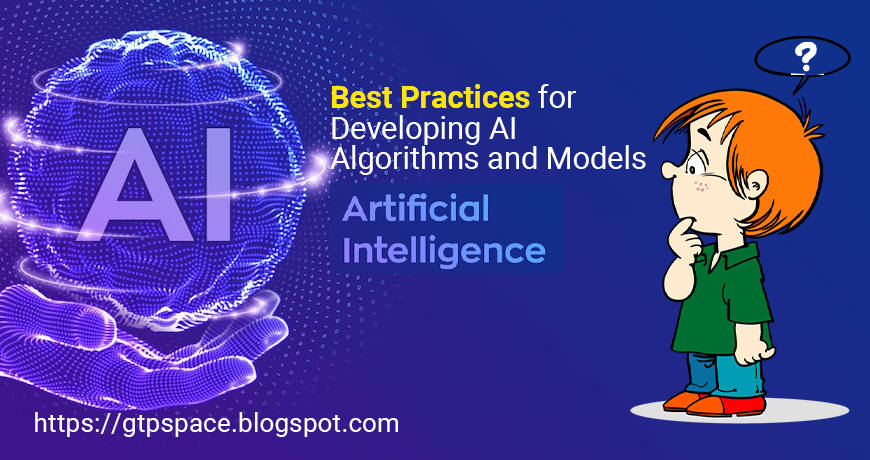Welcome to the exciting world of Artificial Intelligence! With AI-infused products and services becoming ubiquitous, it's no surprise that more companies are jumping on the bandwagon. But, building robust AI models or algorithms is easier said than done; developing effective ones requires a combination of expertise, experience, and good practices. In this post, we'll explore some best practices for creating capable AI models that deliver results across numerous industries from healthcare to transportation. So let's dive in!
Introduction to AI Algorithms and Models
Artificial intelligence (AI) algorithms are at the heart of what enables machines to think and learn. They are used to process and make decisions on a variety of tasks, from identifying objects in images to providing recommendations for products or services.
There is a wide range of AI algorithms and models that can be used for different purposes. The best practice for developing AI algorithms and models is to start with a clear understanding of the task that you want the algorithm or model to perform. Once you have a good understanding of the task, you can select the appropriate algorithm or model type and then begin developing and testing your AI solution.
Some common types of AI algorithms include supervised learning, unsupervised learning, reinforcement learning, and deep learning. Supervised learning algorithms are trained using labeled data, which means that there is a known correct output for each input. Unsupervised learning algorithms are trained using data that is not labeled, which means that there is no known correct output. Reinforcement learning algorithms are trained using a process of rewards and punishments in order to learn how to take actions that will lead to the desired goal. Deep learning algorithms are able to learn complex patterns in data by training multiple layers of artificial neurons.
Once you have selected an appropriate algorithm or model type, you will need to implement it in code and train it on data. This process can be time-consuming and requires significant computing resources. After training your AI algorithm or model, you will need to evaluate it on
Essential Elements of AI Development
There are a number of essential elements to consider when developing AI algorithms and models. Firstly, it is important to have a clear understanding of the task or problem that you are trying to solve. This will help to ensure that your algorithm is able to learn the relevant features and patterns in the data. Secondly, you need to select an appropriate AI technique or algorithm for the task. This selection should be based on your understanding of the problem and the available data. Thirdly, you need to evaluate your algorithm's performance on relevant data sets. This will help you to identify any potential problems and improve the accuracy of your results. Finally, it is important to deploy your algorithm in a practical setting and monitor its performance over time.
Popular Types of Algorithms and Models
There are many different types of algorithms and models that can be used for AI applications. Some of the most popular include:
- Decision trees: These are commonly used in supervised learning tasks to identify patterns in data.
- Neural networks: These are a type of machine learning algorithm that is inspired by the structure of the brain. They are commonly used for tasks such as image recognition and classification.
- Support vector machines: These are another type of supervised learning algorithm that can be used for tasks such as classification and regression.
- k-means clustering: This is a type of unsupervised learning algorithm that is used to group data points together based on similarity.
Different Levels of Expertise in the AI Field
There are different levels of expertise in the AI field. Some people may be experts in one area, such as machine learning, while others may be experts in multiple areas, such as natural language processing and computer vision.
One way to become an expert in the AI field is to specialize in a particular area. This could involve taking courses or attending conferences that focus on that area. For example, if someone wants to become an expert in machine learning, they could take courses on supervised and unsupervised learning, and participate in machine learning competitions.
Another way to become an expert in the AI field is to work on a variety of projects that use different AI techniques. This could involve working on projects that use different types of data, such as text, images, or audio. By working on a variety of projects, people can learn about different AI techniques and how to apply them to different types of data.
How to Optimize the Performance of AI models
There are a number of ways to optimize the performance of your AI models. Below are some tips to help you get the most out of your machine-learning models:
1. Choose the right model for the task at hand. Not all machine learning models are created equal. Some better are suited for the certain tasks than others. When choosing a model, be sure to select one that is appropriate for the task you're trying to solve.
2. Train your model on high-quality data. The quality of your training data will directly impact the performance of your machine-learning model. Use clean, accurate, and up-to-date data when training your model.
3. Evaluate your model frequently. It's important to evaluate your machine learning model regularly in order to identify areas where it can be improved. By doing so, you can adjust your models accordingly and ensure that they're always performing at their best.
Common Mistakes to Avoid When Developing an AI Model
There are a number of common mistakes that can be made when developing AI models. Some of the most common include:
1. Not Defining the Problem Clearly: It is important to take the time to clearly define the problem that you are trying to solve with your AI model. Without a clear understanding of the problem, it will be difficult to develop an effective solution.
2. Overlooking Data Quality: The quality of your data plays a critical role in the success of your AI model. If your data is inaccurate or incomplete, your results will be as well.
3. Choosing the Wrong Algorithm: There are a variety of different algorithms that can be used for AI applications. It is important to select the algorithm that is best suited for the task at hand.
4. Not Validating Your Model: Once you have developed your AI model, it is important to validate its performance on test data. This will help ensure that your model is effective and avoid any issues when deploying it in a real-world setting.
5. Not Monitoring Your Model: Even after your AI model has been deployed, it is important to monitor its performance and make sure that it continues to function as expected.
Conclusion
The best practices outlined in this article will help you develop AI algorithms and models that are reliable, accurate, and capable of producing meaningful results. No doubt there is a lot to learn when creating an AI system as well as a few common challenges to overcome along the way. We hope these tips and guidelines have shown how important it is to choose the right data sets, build robust training processes, and test your systems thoroughly before going into production. By following these best practices, you can ensure that your AI solution functions properly now—and continues to do so in the future.














